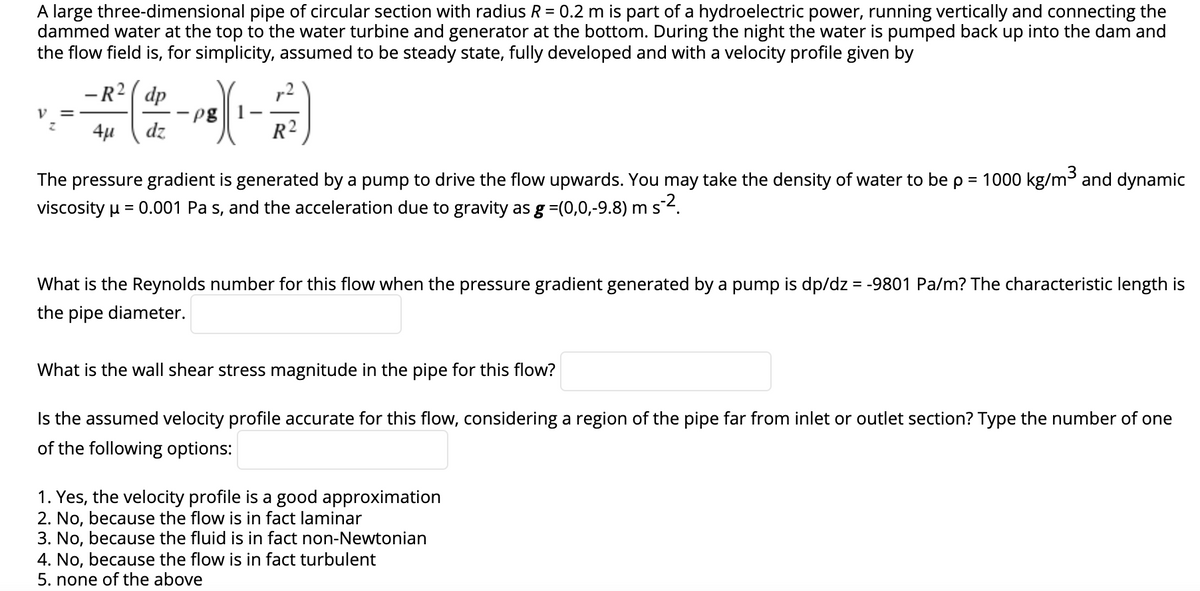A large three-dimensional pipe of circular section with radius R = 0.2 m is part of a hydroelectric power, running vertically and connecting the dammed water at the top to the water turbine and generator at the bottom. During the night the water is pumped back up into the dam and the flow field is, for simplicity, assumed to be steady state, fully developed and with a velocity profile given by V = dp -² (1-3 (1-2) 4μ dz The pressure gradient is generated by a pump to drive the flow upwards. You may take the density of water to be p = 1000 kg/m³ and dynamic viscosity μ = 0.001 Pa s, and the acceleration due to gravity as g =(0,0,-9.8) m s². What is the Reynolds number for this flow when the pressure gradient generated by a pump is dp/dz = -9801 Pa/m? The characteristic length is the pipe diameter. What is the wall shear stress magnitude in the pipe for this flow? Is the assumed velocity profile accurate for this flow, considering a region of the pipe far from inlet or outlet section? Type the number of one of the following options: 1. Yes, the velocity profile is a good approximation 2. No, because the flow is in fact laminar 3. No, because the fluid is in fact non-Newtonian 4. No, because the flow is in fact turbulent 5. none of the above
A large three-dimensional pipe of circular section with radius R = 0.2 m is part of a hydroelectric power, running vertically and connecting the dammed water at the top to the water turbine and generator at the bottom. During the night the water is pumped back up into the dam and the flow field is, for simplicity, assumed to be steady state, fully developed and with a velocity profile given by V = dp -² (1-3 (1-2) 4μ dz The pressure gradient is generated by a pump to drive the flow upwards. You may take the density of water to be p = 1000 kg/m³ and dynamic viscosity μ = 0.001 Pa s, and the acceleration due to gravity as g =(0,0,-9.8) m s². What is the Reynolds number for this flow when the pressure gradient generated by a pump is dp/dz = -9801 Pa/m? The characteristic length is the pipe diameter. What is the wall shear stress magnitude in the pipe for this flow? Is the assumed velocity profile accurate for this flow, considering a region of the pipe far from inlet or outlet section? Type the number of one of the following options: 1. Yes, the velocity profile is a good approximation 2. No, because the flow is in fact laminar 3. No, because the fluid is in fact non-Newtonian 4. No, because the flow is in fact turbulent 5. none of the above
Elements Of Electromagnetics
7th Edition
ISBN:9780190698614
Author:Sadiku, Matthew N. O.
Publisher:Sadiku, Matthew N. O.
ChapterMA: Math Assessment
Section: Chapter Questions
Problem 1.1MA
Related questions
Question
please provide step-by-step calculations

Transcribed Image Text:A large three-dimensional pipe of circular section with radius R = 0.2 m is part of a hydroelectric power, running vertically and connecting the
dammed water at the top to the water turbine and generator at the bottom. During the night the water is pumped back up into the dam and
the flow field is, for simplicity, assumed to be steady state, fully developed and with a velocity profile given by
V =
Z
-R² dp
4μ dz
-pg
R²
The pressure gradient is generated by a pump to drive the flow upwards. You may take the density of water to be p = 1000 kg/m³ and dynamic
viscosity μ = 0.001 Pa s, and the acceleration due to gravity as g =(0,0,-9.8) m s-².
What is the Reynolds number for this flow when the pressure gradient generated by a pump is dp/dz = -9801 Pa/m? The characteristic length is
the pipe diameter.
What is the wall shear stress magnitude in the pipe for this flow?
Is the assumed velocity profile accurate for this flow, considering a region of the pipe far from inlet or outlet section? Type the number of one
of the following options:
1. Yes, the velocity profile is a good approximation
2. No, because the flow is in fact laminar
3. No, because the fluid is in fact non-Newtonian
4. No, because the flow is in fact turbulent
5. none of the above
Expert Solution
This question has been solved!
Explore an expertly crafted, step-by-step solution for a thorough understanding of key concepts.
Step by step
Solved in 5 steps with 24 images

Knowledge Booster
Learn more about
Need a deep-dive on the concept behind this application? Look no further. Learn more about this topic, mechanical-engineering and related others by exploring similar questions and additional content below.Recommended textbooks for you

Elements Of Electromagnetics
Mechanical Engineering
ISBN:
9780190698614
Author:
Sadiku, Matthew N. O.
Publisher:
Oxford University Press

Mechanics of Materials (10th Edition)
Mechanical Engineering
ISBN:
9780134319650
Author:
Russell C. Hibbeler
Publisher:
PEARSON

Thermodynamics: An Engineering Approach
Mechanical Engineering
ISBN:
9781259822674
Author:
Yunus A. Cengel Dr., Michael A. Boles
Publisher:
McGraw-Hill Education

Elements Of Electromagnetics
Mechanical Engineering
ISBN:
9780190698614
Author:
Sadiku, Matthew N. O.
Publisher:
Oxford University Press

Mechanics of Materials (10th Edition)
Mechanical Engineering
ISBN:
9780134319650
Author:
Russell C. Hibbeler
Publisher:
PEARSON

Thermodynamics: An Engineering Approach
Mechanical Engineering
ISBN:
9781259822674
Author:
Yunus A. Cengel Dr., Michael A. Boles
Publisher:
McGraw-Hill Education

Control Systems Engineering
Mechanical Engineering
ISBN:
9781118170519
Author:
Norman S. Nise
Publisher:
WILEY

Mechanics of Materials (MindTap Course List)
Mechanical Engineering
ISBN:
9781337093347
Author:
Barry J. Goodno, James M. Gere
Publisher:
Cengage Learning

Engineering Mechanics: Statics
Mechanical Engineering
ISBN:
9781118807330
Author:
James L. Meriam, L. G. Kraige, J. N. Bolton
Publisher:
WILEY